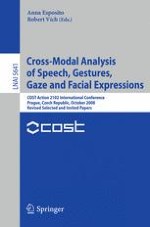This volume brings together the peer-reviewed contributions of the participants at the COST 2102 International Conference on “Cross-Modal Analysis of Speech, Gestures, Gaze and Facial Expressions” held in Prague, Czech Republic, October 15–18, 2008. The conference was sponsored by COST (European Cooperation in the Field of Scientific and Technical Research, www. cost. esf. org/domains_actions/ict) in the - main of Information and Communication Technologies (ICT) for disseminating the research advances developed within COST Action 2102: “Cross-Modal Analysis of Verbal and Nonverbal Communication” http://cost2102. cs. stir. ac. uk. COST 2102 research networking has contributed to modifying the conventional theoretical approach to the cross-modal analysis of verbal and nonverbal communi- tion changing the concept of face to face communication with that of body to body communication as well as developing the idea of embodied information. Information is no longer the result of a difference in perception and is no longer measured in terms of quantity of stimuli, since the research developed in COST 2102 has proved that human information processing is a nonlinear process that cannot be seen as the sum of the numerous pieces of information available. Considering simply the pieces of inf- mation available, results in a model of the receiver as a mere decoder, and produces a huge simplification of the communication process.
